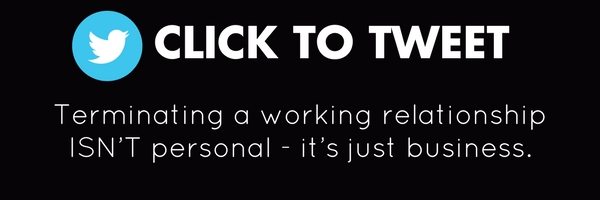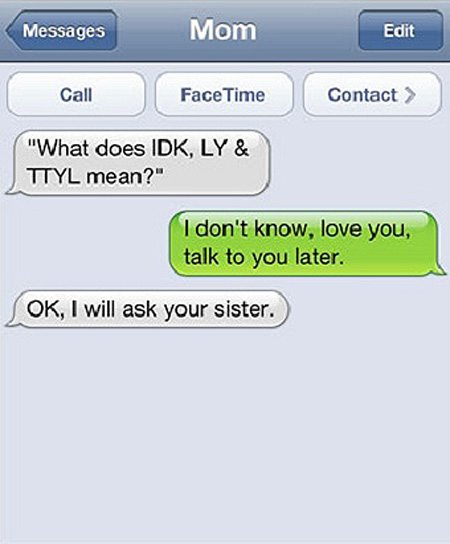How To Fire a Client
Posted by:
Abbey Ashley
So the time has come for you to fire a client, eh?
It’s a tough realization to make, and once you do – it can be even tougher to know how to handle it appropriately.
It’s kiiiiinda like being on a date with someone who makes an AMAZING first impression…
Maybe they told you all the things you wanted to hear, and the two of you seemed like a perfect match. You both giggled and swooned all night, finding lots of things in common, and now you both want to continue the relationship after that first date.
You tell your girlfriends it’s a match made in heaven (he might be THE ONE to make all your dreams come true!).
Then, after a few more dates… the relationship turns unexpectedly sour.
He calls you at weird hours and ends up being super needy.
Or maybe he grows disinterested and aloof and won’t return YOUR calls.
It’s quite possible he turns out to be arrogant and corrects your every move.
He might expect you to pay for dinner, or worse… insults your mom at a family dinner.
Either you rely on him too much since you already told everyone he was “the one”
OR
Maybe you knew right from the start he wasn’t “the one,” but you continued the relationship out of desperation.
We’ve all been there. We operate out of a scarcity mindset, so we don’t look outside of what we have for what we deserve. We can easily grow desperate for time, attention, money, validity, or permission
Ending a relationship is awkward and uncomfortable.
Firing a client can feel the exact same way.
Today, I’m going to show you step-by-step how to fire a client WITHOUT burning any bridges.
Table of Contents
WHAT’S STOPPING YOU?
Before we jump into the juicy details of how to fire your client, let’s first look at what it is that’s holding you back.
Aka… if you’re reading this post, why haven’t you pulled that trigger yet!?
For most people, the reason that they are scared to fire a client is simply because of fear itself.
Fear of losing the stream of income.
Fear of confrontation.
Fear of failing in business.
When it comes to facing those fears, there are a few reminders that you need to tell yourself:
Reminder #1: I left my 9-5 to be happier.
The reason many of you started your business was to leave your 9-5. Be real. You know you hated it.
If you left (or plan to leave) a job that you didn’t enjoy, why trap yourself with clients that you don’t enjoy working with?
The truth is, sometimes in business you will have to do things that you don’t like. It’s part of adult-ing.
But there is a difference between making yourself do your taxes and sticking with a 20 hour a week client that you can’t stand.
If you left your 9-5 to be happier with your life and working environment, remember to keep prioritizing that in your business.
Reminder #2: There ARE more clients waiting for me.
One of the scariest parts of firing a client is that fear of losing that stream of income.
This fear comes from the scarcity mindset. We are scared that there are not enough clients, money, or work to go around.
It’s simply not true. You landed this client, right? If you were able to secure one client, you can secure another.
Need help? Check out our blog post all about selling out your services as a virtual assistant.
When we start operating out of the abundance mindset, this means we understand that we get to CHOOSE who we work with.
We deserve to charge what we are worth, and we deserve to be happy working with clients and businesses that bring us joy.
YOUR business means YOUR rules. You don’t need to have an employee mentality any longer!
Reminder #3: Confrontation doesn’t have to be a bad thing.
If you tell yourself, “This is going to be a terrible conversation”, then it most likely will be.
I HATE confrontation.
I know it comes from a deep-down need to be liked. Confrontation means that the person on the other end may think badly of me, and that seriously KILLS me.
But something I’ve recently learned is that confrontation doesn’t have to be a bad thing.
It’s all about the approach. I’ve found that being honest and owning the situation (aka not pointing fingers) is a great way to have conversations instead of confrontations.
Most of the time, the conversations don’t go as badly as we anticipate they will!
If you’re resonating with what I’m saying but you are still unsure, the best advice I’ve ever received is just to do it scared.
You’ll feel nervous at first (shaky voice syndrome, anyone?), but the relief you feel afterward will embolden you that you made the right choice.
HOW TO FIRE A CLIENT
We’ve identified some of the fears that could be stopping you from firing a client, now – let’s look at the step-by-step process of HOW to do it.
STEP#1: KNOW WHEN IT’S TIME
I would bet that you started your business because you didn’t like working as an employee for someone else. Maybe you felt stuck.
Guess what? You get to choose who you work with. If they don’t bring you joy, you have the freedom to let them go.
Here is how to know when it’s time to fire a client:
First, assess your emotions. Whenever you think about the client, communicate with the client, or perform work for the client, do you feel any of these emotions?
• Dread
• Reluctance, hesitation, or paralysis
• Frustration or stress (the bad kind)
• Bored or annoyed
• Lack of excitement
I remember feeling this way exactly right before I fired my first client. Every time I would get an email from her (which was about 12 times a day), I would get this sick feeling in my stomach. I didn’t want to open the email, because I knew I was going to be upset at what was inside.
If you are not excited to do client work, you will not do it to the best of your ability. Not only do you deserve to love what you do, but the client also deserves good work from someone who is genuinely excited to do it.
Second, assess your client relationship. Ask yourself if a client has consistently portrayed any of the following characteristics?
This client…
- Doesn’t respect boundaries for turnaround or communication time.
- Tries to push project boundaries by asking/expecting too much out of scope, and/or doesn’t understand the amount of work involved.
- Won’t delegate projects/tasks.
- Micromanages projects/tasks and doesn’t trust you to do the assigned work.
- Has evolving needs that you can’t meet anymore (i.e. ability to meet more often or take on more work, etc.).
- Is verbally/emotionally manipulative or abusive.
- Regularly doesn’t pay on time.
- Has vastly different personality traits and/or stylistic preferences from you.
- Doesn’t fit your niche criteria anymore.
- Isn’t willing to pay you more when you raise your rates, AFTER you’ve already proven your worth.
If any of the above sounds familiar… it’s time to move on.
One quick piece of advice here.
I recommend taking a few days to make this decision. It’s not something that should be made rashly or out of emotion.
Speaker, Author, and former CEO of Thomas Nelson Michale Hyatt quotes in his blog that, “Before you fire a client who has done something that you don’t like, do some evaluation. Ask yourself: Is this a pattern of behavior or is this a one-off? All of us can have monster moments”.
Don’t we all know THAT is true!
Make sure that you are seeing a recurring pattern of behavior before you decide to sever your contract.
STEP #2: KNOW YOUR RIGHTS AS AN INDEPENDENT CONTRACTOR.
When you first started your working relationship with your client, you both signed a contract.
In the contract, it (should have) stated that you are an independent contractor. This means that specifically under the law, you are NOT an employee.
See related post: What is an Independent Contractor?
There are certain rights that come with that designation. As an independent contractor, you have the right to work where you want, when you want, and to work for several clients at once. If you are not happy working with a client, and you know that you will not provide your best work to the client, you don’t have to be stuck there.
One of the awesome rights of being an independent contractor is that either party can terminate the working relationship, and for any reason.
Know that, as an independent contractor, you have a right to terminate the relationship without legal or workplace repercussions.
*Sigh* … that’s a relief, right?
STEP #3: KNOW YOUR RESPONSIBILITIES AS AN INDEPENDENT CONTRACTOR.
Having rights doesn’t come without the balancing act of also having responsibilities.
One of the duties of being a responsible business owner is that you treat other business owners with respect, even if you’ve had your differences or the relationship has been a little rocky.
(You know, the whole treat others how you want to be treated thing.)
You owe your client all work completed up until the time of termination that has been paid for. If a project doesn’t have a tangible end-result, it’s a really good idea to send a task or time log of work and/or hours completed.
You also have the responsibility to delete all login information, passwords, and/or credentials that have been stored in your computer/phone.
Pro Tip: We love using Lastpass* to store passwords for our clients!
*Yes, I’m an affiliate for LastPass… only because I SERIOUSLY love it!!!
Remember, all contractors have the unspoken responsibility to deliver their best work. If this isn’t happening for any reason, then you have to keep the client’s best interest in mind, as well as your own.
STEP #4: CONSULT YOUR CONTRACT.
Your contract should have a well-laid out termination provision in place.
Basically, you need to figure out what you and the client owe each other before saying farewell. Over time, you may find it necessary to add to the termination provision according to various situations you have encountered.
Danielle Liss at Businessese is a friend of mine and an attorney for bloggers and influencers.
Here is what she says about the termination provision in your contract:
“When you are ready to end a client relationship, review your contract so you know what your termination provision says. Typically, you will need to notify your client in writing and give them a specific amount of notice. You can also ensure that it states you will be paid for the work done until the time of the termination. Depending on how your packages are structured, you can include things like refunds for incomplete work, etc.”
Uh oh… don’t have a contract?! Get yourself covered!
Grab your contract written specifically for virtual assistants at a low price now with our VA Toolbox.
STEP #5: DON’T DELAY.
Usually, if a relationship is going south, both sides know it.
One time, I worked for a client that I really liked. He was a high-end client, meaning that he had me working for him about 15 hours per WEEK. However, over time, I knew the type of person he needed to have working for him, and I knew I wasn’t it.
When I mustered up the courage to have the conversation, I realized he felt a similar way – he needed someone with a different availability than I had personally. We both felt relieved as we realized we had come to a similar conclusion after months of working together.
I respected him as a person and as a business owner – I still do, today. And we have peacefully moved on in our life and in our business as friends.
A helpful thing to remember is that terminating a working relationship ISN’T personal – it’s just business.
Getting the words out will also help you feel a million times better.
Remember – as you grow in your business, you will need a symbiotic relationship with your clients. In order for you to grow together, your client will need to have the capacity for you to take on more responsibility over time (if you are truly helping them grow in their business) and be willing and able to pay you more as you prove your value and worth.
STEP #6: MAKE A PLAN.
Figure out how much time and income the client currently gives your business. You will need to make a plan for bringing in subsequent income once you and the client are no longer working together. What do you need in order to maintain your current level of income/hours?
Make a plan so that you can feel prepared about how to move on BEFORE having the termination conversation.
If possible, start pitching new proposals before the current relationship is officially over so that you have little, if any, gap between clients.
PRO TIP: This is also a reason that I recommend that all virtual assistants and freelancers work to have a 3 months living expense / emergency fund in their savings account. This will help to keep you afloat if there is some time in between finding that next client.
STEP #7: MEET WITH THE CLIENT.
Here we go…
The time has come to actually have the conversation with your client.
Of course, this part of the process will vary widely depending upon how you and the client have regularly been communicating, how long you have been working together, and what type of relationship that you have.
Unless the client is someone you just started working with and has ONLY communicated through email, I recommend at least a phone call, if not a video call or in-person meeting.
I know you may hate me for saying that (shoutout to all the non-confrontational people out there). But here is my reasoning behind this:
SO much can be misinterpreted via text message and email. You know this is true.
A phone call, video meeting, or in-person meeting is always going to be the best route for this type of conversation. You and your client can read each others tone and emotion, which makes it easier to communicate that you do have their best interest at heart.
The best way to word a termination conversation is to begin with:
“After working together for [x amount of time], I truly believe that I am not the best fit for this project/position as the most effective long-term solution. I don’t have the capacity/availability to perform the work to the best of my ability. I know that what you need is [x], and I can only offer [y].”
Frame the conversation as if you are mainly thinking about the client’s best interest, and don’t make it only about yourself.
STEP #8: GET IT IN WRITING.
Regardless of how you met with the client in the previous step, get EVERYTHING in writing.
I recommend a follow-up email after the termination conversation.
You may also want to send an email like this if you are unable to connect with your client in person or via phone or video call.
Remember, one of the responsibilities that you have as an Independent Contractor is to document all aspects of the working relationship. You need to have proof of the termination of the relationship, including when it occurred, what the termination agreement was, and any documentation of work completed IN WRITING.
This way, your butt is covered just in case a client turns sour after the fact.
Keep all documentation organized and in a safe place, so you can easily and quickly reference it, if necessary.
STEP #9: DON’T BURN THE BRIDGE.
Remember, every client you work with is a chance to gain a testimonial. Past clients also retain the potential of giving you future referrals if you play your cards right.
The last thing you want is a client who has a bad taste in their mouth about you and your work, or worse… a past client with a mean streak who will sabotage your online marketing efforts.
Bad reviews can be a pain, if not impossible, to get rid of in the online sphere, and they are hard to recover from. (Again, this is why you want to document everything in writing – just in case.)
You want the personal relationship to continue amicably (even if just on social media), long after the business relationship has ended.
A parting thank you note for the chance to work together or a small gift is an amazing finishing touch that will ensure positively glowing reviews.
STEP #10: MOVE ON.
Chances are, the relief that you immediately feel can be quickly replaced by panic.
However, don’t dwell on the past. Trust your past self and your intuition that you made the right decision. There are plenty of other clients that ARE the right fit for you.
Work hard, take your time, and put a lot of personal touches on new proposals. In the future, if you feel icky during the discovery call with a potential client or see ANY red flags, don’t accept the client.
Learn from your past experiences, and make a toast. Here’s to creating the business of your dreams!
CONCLUSION
Firing a client doesn’t have to be hard, long, or drawn out. Following this step-by-step process takes the guesswork out of how to actually fire your first client.
Here’s a recap of those steps:
- Know when it’s time.
- Know your rights.
- Know your responsibilities.
- Consult your contract.
- Don’t delay.
- Make a plan.
- Meet with the client.
- Get it in writing.
- Don’t burn the bridge.
- Move on.
Firing a client doesn’t have to be a terrible experience. By following this intuitive guide, you can end the working relationship amicably while still maintaining your good reputation (and your sanity!).

Meet Abbey
Abbey Ashley is the Founder of The Virtual Savvy. She helps aspiring virtual assistants launch and grow their own at-home business from scratch. She's since gone on to grow a multi-six figure business and retire her husband ALL from her at-home business. It's now her passion to help others start their own VA business so they can taste the freedom and flexibility of entrepreneurship as well.

This free one-hour training combines thousands of hours of research, years of experience in growing a virtual assistant business!
Popular Posts
Looking for More?
Read posts from our most popular categories.
*This post may contain affiliate links. This means I may earn a small commission (at no cost to you) if you sign up for a program or make a purchase using my link!
4 Comments
Leave a Comment
What is the SavvySystem: VA Launch Academy?
What is the SavvySystem: VA Launch Academy? This is The Virtual Savvy’s signature Virtual Assistant program. The SavvySystem: VA Launch Academy is a step-by-step blueprint for launching and growing your own profitable at-home business from scratch.
Check these out
RECOMMENDED READS
1
Do you ever feel STUCK in your business? Like your…
Read More2
Sorry, we couldn't find any posts. Please try a different search.


















Thank you for this post, I found it to be very informative as it helped me with a situation I’ve been experiencing with my client. You hit the nail on the head about the stress I felt when there was an email from her in my inbox, I started to avoid my computer… I was so unhappy. This client was doing several things mentioned in your post, not respecting my time, constantly adding action items to a project when it was almost completed one email at a time. It was time to let them go.
Thank you for helping me get back my control in a professional way.
You are so very welcome!
This is such a great post. No, it’s more than that. It’s a short course in how to respectfully part company from a client. And it is so good!
Isabelle, thank you so much! I really appreciate your feedback and am so glad that you found value in this article!